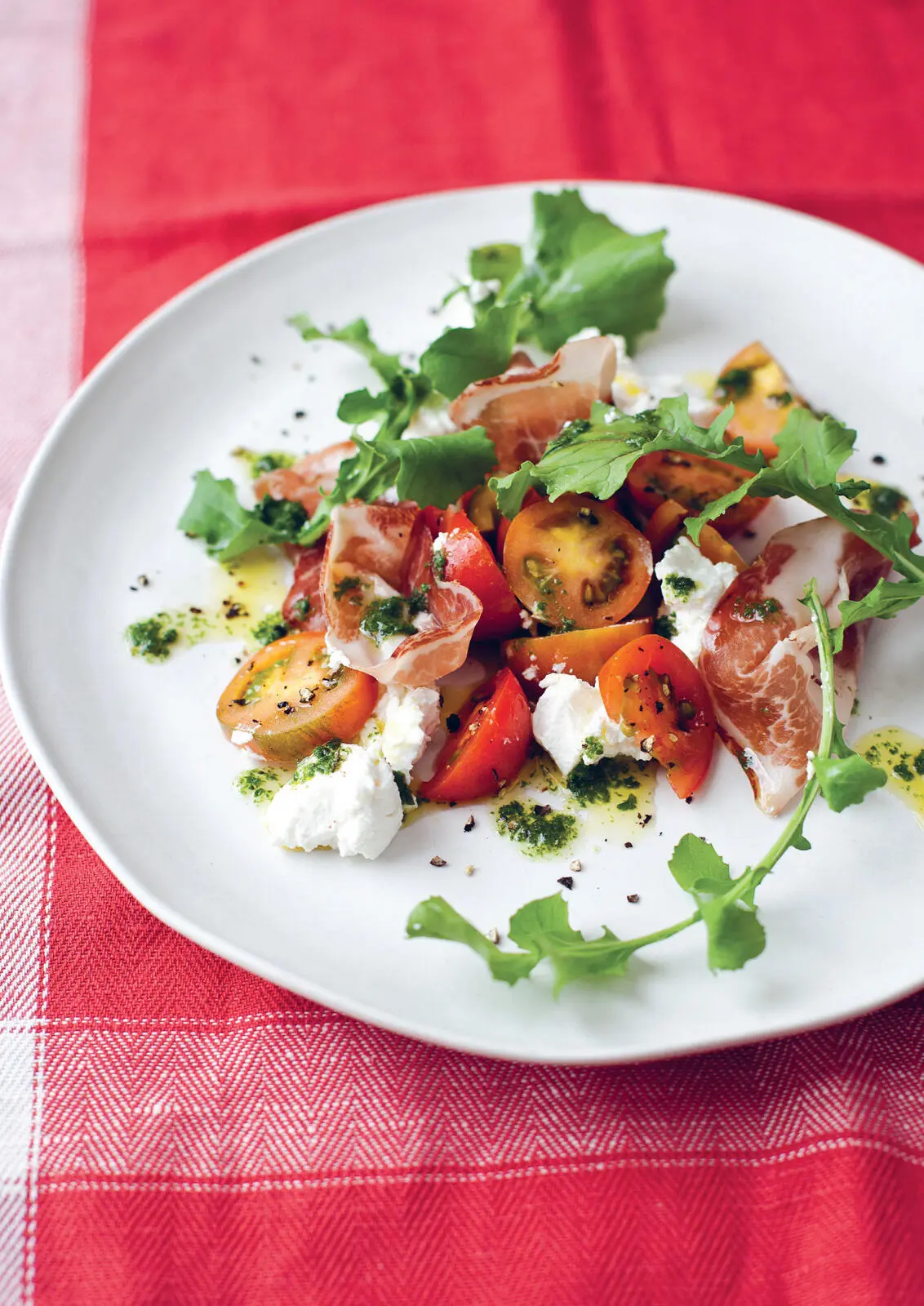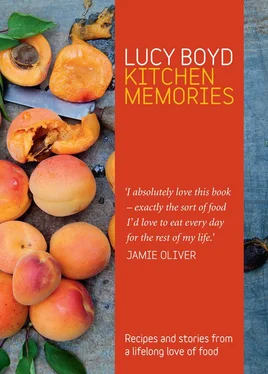Rocket will self-seed if you leave the flowers on. Sow direct around mid-March as the ground starts to warm up.
My memories of cooking with Rose picture her slicing, prodding, mixing, tying, rolling, chopping – she loved her mezzaluna for chopping the herbs when she was making salsa verde. Kitchen equipment essentials were quite basic. Pasta was rolled out with a glass bottle if the rolling pin couldn’t be found. Mayonnaise was made in the pestle and mortar; pastry, cakes, eggs and cream were hand-whisked in a bowl. Meat was minced in a hand-operated meat grinder clamped to the side of the table.
Not having a food processor or KitchenAid made the preparation of food both social and instructive; friends would be given a board, a knife and a glass of wine with directions on how finely to chop the garlic or how to remove the sprouting, bitter green shoot in the winter cloves. Peppercorns were crushed in a crude wooden bowl with a large round stone just before cooking so that their oils remained fresh. Pressing ‘pulse’ on the processor seemed a cold and distant way to chop the civilising herbs … Rose’s hands were constantly moving like little birds – lots of contact with whatever ingredient was being prepared seemed to bring life into every aspect of the making of a meal. A good friend remarked, after Rose’s death, that she had taught him how to live.
Rose was an incredible teacher in that you came away from your experience of cooking with her and somehow life had changed. Her attention to the possibilities of the ingredients she used and the nature and character of the condition they were in would determine how she prepared and cooked them. She was also quite scary – if I questioned whether it was really necessary to peel the individual skins off every chickpea she had boiled (and a normal 500g packet is a lot of chickpeas), she would give me one of her intensely penetrating glares.

CAMONE TOMATO, COPPA DI PARMA AND RICOTTA SALAD
‘Camone’ tomatoes arrive at the beginning of spring, imported from Sicily. They are sold on the stem with medium-sized greeny-red fruits. They have a tangy quality that reflects the lack of sun that sweetens the tomatoes later in the season. I love the firm texture and taste of this tomato, which goes so well with the light and creamy ricotta and the deep earthy and sweet flavours of the coppa (the cured rolled shoulder of pig).
1 small bunch of fresh marjoram, leaves picked from their stems, washed and dried (about 3 tbsp of leaves)
extra-virgin olive oil
1 lemon
3–4 ‘Camone’ tomatoes (or ‘Marinda’, another early variety with a firm, slightly crunchy texture and fantastic flavour)
12 slices of coppa di Parma (cured pork shoulder)
150g buffalo ricotta
a few leaves of broad-leaved rocket or lamb’s lettuce, washed and dried
sea salt and black pepper
Make the salmoriglio (sauce) by crushing the marjoram leaves with a pinch of sea salt in the pestle and mortar until a rough paste is formed. Add 2 tablespoons of extra-virgin olive oil and a squeeze of lemon and stir together.
Slice the tomatoes in half crossways (not through the stem) and then cut roughly into pieces so that you have odd shapes. Season with a little salt (remember that the salmoriglio has some in) and pepper and coat with a little extra-virgin olive oil.
Put a few pieces of tomato on to each plate, divide the coppa up and curl it through the tomatoes as if it were unfolding. Spoon teaspoons of the buffalo ricotta over the salad and add a few rocket or lamb’s lettuce leaves. Dribble the salmoriglio sparingly over the top.
We had rabbits as pets when we were little. My brother Dante refused to let our mother put rabbit on the menu at the River Café for years and then one day it featured: the pet was on the plate.
Nothing makes me feel like spring is here more than broad beans. I love them with rabbit cooked with herbs, carrots and some white wine.
Farmed rabbit flesh is delicate and tender compared to wild rabbit, which tends to be tougher and has a stronger, gamier flavour.
1 whole rabbit, cut into its various parts, legs removed and saddle cut into similar-sized pieces (the butcher will do this)
20–30g unsalted butter
olive oil
4–6 spring carrots, washed, ends trimmed, chopped at an angle about cm thick
2 celery sticks, ends trimmed, cut into 1cm thick slices
2 garlic cloves, peeled and finely chopped
4 slices of pancetta or good-quality smoked streaky bacon, cut into mm pieces
a few sprigs of fresh rosemary or thyme, washed and dried
500ml good-quality dry white wine
salt and black pepper
Use a heavy-based pan with a lid that is large enough to hold the rabbit and the juices. Season the rabbit well on all sides with salt and pepper.
Put the pan on the heat and add half the butter and a drizzle of olive oil. When the butter starts to sizzle, add the rabbit pieces and brown the meat on all sides, then remove them to a plate. You may not have room in the pan to brown all the rabbit in one go, in which case do a few pieces at a time.
Add the remaining butter to the pan with 1 tablespoon of olive oil and the carrots and celery. Let them sweat gently for 8–10 minutes until they become slightly soft on the outside. Add the garlic and pancetta and continue to cook over a medium heat until the pancetta is just about to start turning golden in colour, then add the rosemary or thyme sprigs. Put the rabbit pieces back in the pan with any juices that have been released and add the wine, which should come about two-thirds of the way up the pan. (The rabbit need not be totally submerged.) Let the wine come to a boil, then put the lid on and turn the heat down to a gentle simmer (or you could put it in the oven at 200ºC (180ºC fan) Gas 6). Cook for about hour, occasionally turning the rabbit pieces over to keep them moist. Serve with broad beans and mint ( see here).
This is a strange time of year for ingredients. It can be cold, windy and frosty with days that have buds on stems outlined by blue skies. Leafy vegetables that grow above ground and need frost to taste their best have been delicious; cavolo nero and the chicory family have kept a balance with all the autumn root vegetables. It is time for change, to lighten up even though the produce remains quite limited. The game season finished at the end of February and the spring lamb has yet to come in.
The forced shoots of rhubarb and sea kale are an early sign of spring and are eaten almost as a delicacy. For me, sea kale marks a transition from the winter months into early spring. By eating the early sprouting shoots it seems as if you are literally eating a mouthful of a season to come.
Thinking about what to cook in March is really about how to change the way I approach the ingredients I have been cooking with all winter. There are new arrivals in the form of early carrots and small baby turnips, which have a vibrancy to them that is incredibly refreshing after months of earthy flavours. Beetroots in the shops, or stored since the autumn, look tired and are soft to the touch, with slackened skin that needs removing before they are boiled or roasted. They look ugly too, their skins like overcoats that have spent too long in the trenches covering the wrong type of sweetness. Whereas in summer beetroots can be pulled from the ground, their skins, taut and full of flavour, are kept on and they are delicious roasted or boiled whole when they are still relatively small and young.
Читать дальше













